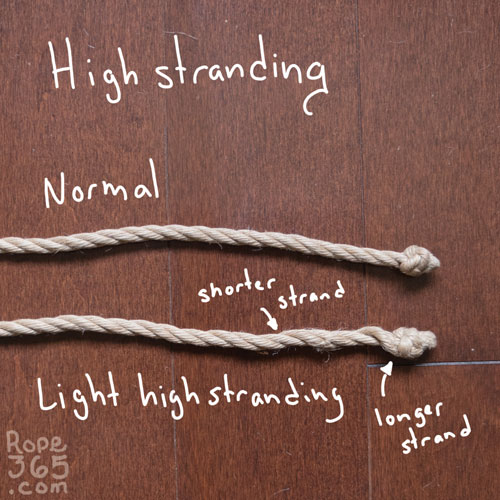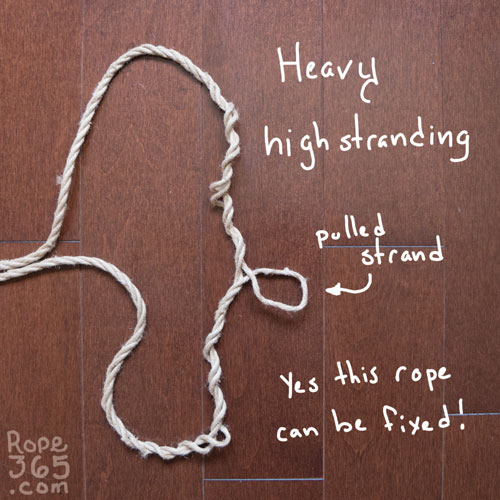Day 48: Maintenance
After some use, we need to make sure we keep our rope in good working order. This means making sure it stays clean, doesn’t dry out, maintains the structural integrity to keep its strength, and sometimes fix the little problems. Your maintenance routine will define how your rope will age and how often you will need to replace them.
When Should I Wash my Ropes?
Deciding how often to clean our rope is a complex topic as it is a decision full of compromise. The cleaning process will progressively weaken the rope, some types of fibre being more vulnerable than others. Each person also has their preferences and needs when it comes to hygiene. Discussing rope maintenance with your partner is part of informed consent.
I’m comfortable wearing my friend’s shirt, but not their underwear. I wash all the clothing bought from the store in case it was worn by a stranger. For most people, their hygiene limits and preference are not just about if the rope was used, but also how it was used and with whom. Some will prefer that their rope is used on them exclusively, others will be perfectly fine with ropes that were used on others over clothing. What about ropes that were used on the mouth, on genitals, or rope that dragged on the floor in a dirty location? It is important to make a conscious choice of what is acceptable or not for everyone involved.
For most people, the main criteria is to limit contamination via rope, especially STI and other infections. No method of cleaning rope can achieve 100% sterility with natural fibre ropes without damaging it. But many types of natural materials used for rope show anti-microbial properties, especially bamboo, but jute and hemp as well. If you are afraid of pathogens from one person infecting another, the only completely safe way is to use a different kit of rope between partners.
We generally want to wash our rope only if needed. Synthetic and cotton ropes are easy to wash, so they can be washed after each use. Hemp and jute gets weaker when wet, and will take time drying under tension. If you decide to wash these rope more often, you might have to replace your kit sooner.
We can combine the different strategies depending on our preference and the type of play. One strategy is to have a set of synthetic rope for messy play, and keep a natural rope kit for more conventional sessions. Have a smaller kit reserved for a specific partner than can be combined with the regular kit, and use those ropes for mouth and genitals. A nice trick is to coil the dirty rope with a different method to only have to wash the ropes that were in contact with dirty stuff. The most important is to have a strategy that works for you and your partner(s).
The Importance of Regular Oiling
Natural rope requires regular oiling to ensure it’s strength and longevity. When natural fibre gets dry, they get brittle and breaks. Oil is most important for natural fibres, synthetic do not require this process.
Oiling rope after washing them is important as the cleaning process will remove some of the oil in the rope. How often you need to add oil depends on how often you use the rope, the climate and the type of rope. Some people like to tie on bare skin, adding “natural oil from the body”, and it is important not to let rope in storage to dry. People in a dry climate will also need to oil their rope more regularly.
Fixing High Stranding
Highstrading will likely appear after lots of use or suddenly by accidentally pulling on one strand more than the others during rope manipulation. This is unlikely to happen on braided ropes, but quite common in twisted ropes.
To fix light high stranding, you can massage the rope by holding it firmly and travelling your hand along the rope a few times. If the rope was balanced in the first place, the tension should progressively adjust itself. Make sure you do it in both directions to keep the rope even. After some time of using a rope, some strands might naturally stretch more than others. To fix this you will need to open the end of the rope to shorten one or two strands to rebalance it.
For more intense high stranding, massaging the rope might not be enough. The strategy then is to untwist it at the location of the problem, and manually retwist it until it falls back into place. Some additional massaging is generally necessary after this to smooth things out. The good news is that even if a rope gets pulled in pretty bad high stranding, it can be completely fixed with some patience.
High stranding on a yarn inside a strand are much harder to fix, these are usually a sign of uneven tension during the rope making process. It is recommended to avoid this kind of rope when strength is important as this is generally the sign that the tension inside the rope might weaken it.
Practice Time!
Try out different techniques and update your maintenance protocol for your rope. Break it, fix it!
Exploration ideas
- Discuss with your friends and partners on their limit and preferences when it comes to rope hygiene
- Oil your rope and take note on how long before they start to feel dry again. Try different types of oil to compare.
- Try fixing some high stranding, no high stranding in your rope yet? Just pull very strongly on one strand until the rope unravels itself. Then proceed to retwist the rope back into place. Use a rope that has less sentimental value so you can play with the strands comfortably.
- Try with ropes that have different tightness of lay. High stranding is much easier to fix on a looser lay rope.
Inspirations and Resources
- “How do I clean rope” and other musings by Treezy
- Rope Care, video by M0co
- Fixing high stranding by WykD Dave
- How to Care for you Ropes, video by Avalon
- Rope Maintenance, video by BelleCorde
- Notes for class: Hygiene for BDSM by Neuromancer28
Credit: R/P: Ebi McKnotty
Or return to The Rope for more options.




2023-05-20 at 6:24 AM
Hi! Have a couple of questions about rope treatment. Is it necessary to oil cotton rope as well? how much oil do I need to use to be sure that the rope is fully oiled? I would also like to know if there is any way to reduce the amount of rope fibers falling from it during the session.
2023-05-20 at 7:19 PM
I don’t use cotton regularly, so I’m making suggestions but recommend making your own exploration. Oil is used to prevent the rope from becoming dry, to my knowledge this is not necessary with cotton as the fiber is pretty good at keeping humidity.
To prevent natural rope from doing fuzz, singing (burning the rope) will get rid the small hair. I’m surprised this is happening with cotton, you may want to check alternate products to see if they make less fuzz. With jute/hemp, as the rope mature it makes less and less fuzz but I’m not sure with cotton.